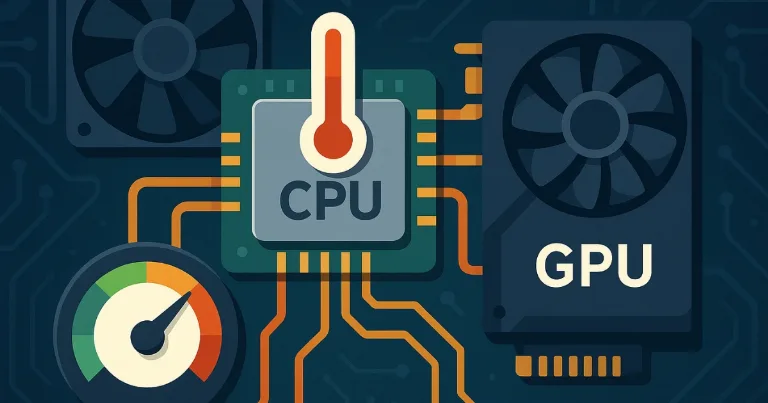What Overclocking Means on a PC, An Easy Explanation

By Alex David Du · Published
Alex writes about gaming, tech, and simple online income ideas, and builds projects that bring ideas to life.
I think of overclocking like lifting a car speed limiter a little. Same engine, same road. You let it go a bit faster, but you also watch the gauges and make sure the radiator can keep up. On a PC, that means a part runs a bit faster than its default setting while you keep it cool and stable.
Here is the part that matters for you:
-
In games, higher clocks can lift frame rate and frame time stability when the CPU or GPU is the slow piece.
-
In creative work, higher clocks can cut render and export time if the task is limited by that chip.
-
The gains are usually small but real. Think a few percent to maybe ten on a good day, not a night‑and‑day jump.
What overclocking actually means
In plain words, you tell a part to run a bit faster than normal, and then you make sure it stays cool and stable.
-
Overclocking is setting a component to run faster than the factory base setting.
-
You can overclock the CPU, GPU, and RAM. Each one has its own knobs and limits.
-
The idea is simple. More frequency per second equals more work per second.
-
There is no magic. Every gain must stay stable under load.
A simple picture in your head
Think of a runner. You ask them to take quicker steps. They run faster, but they also get hotter and need water. Your PC is the runner. Cooling is the water.
How the clock, voltage, and heat connect
-
Clock is how many steps per second the chip takes.
-
Voltage is the push that helps each step land clean. Higher voltage can help stability at higher clocks.
-
Heat is the side effect. More clock and more voltage mean more heat.
-
If heat gets too high, parts will throttle, which means they slow down to protect themselves.
Rule of thumb
-
Start by raising clock in small steps.
-
Only add voltage if you must, and only a little.
-
Watch temperatures. Keep a safe ceiling for your chip and cooler.
What changes for games and renders
-
Games draw a frame again and again. If the GPU is the slow part, a GPU overclock can raise FPS. If the CPU is the slow part, a CPU overclock can help, mostly in CPU heavy titles or at lower resolutions where the GPU is not maxed.
-
Renders and exports run math for a long time. If the app leans on the CPU (many 3D and video tasks), a CPU overclock can trim the timer. If it leans on the GPU (some effects and Resolve tasks), a GPU overclock can help.
-
If another part is the limit, like storage or memory bandwidth, overclocking the CPU or GPU may do little. In that case, memory profiles like XMP/EXPO or faster storage help more.
What parts you can overclock, CPU, GPU, RAM
CPU
-
You can raise core clocks or tweak the boost behavior.
-
On Intel chips, there is Turbo Boost, which is automatic extra speed when there is room.
-
On AMD Ryzen, there is Precision Boost and PBO (Precision Boost Overdrive) that can raise limits so the chip boosts harder when power and temps allow.
GPU
-
Bump the core clock and memory clock in small steps.
-
Many apps let you raise the power limit a little so the card can hold higher clocks longer.
RAM
-
Memory speed and timing affect game frame times and some creator tasks.
-
Modern boards support ready made profiles like XMP on Intel and EXPO on AMD to set rated speeds quickly.
Auto boost vs manual, Intel Turbo, AMD Precision Boost, PBO
Auto boost
-
Your CPU already boosts on its own within safe limits. This is the default on modern Intel and AMD chips.
-
It adjusts hundreds of times per second based on power, temperature, and workload.
Manual or assisted
-
Manual CPU overclocking sets fixed multipliers and voltages. It is simple to measure, but it may run hotter.
-
On AMD, PBO can lift power and current limits so the built‑in boost uses more headroom. Think of it like raising the gym’s ceiling so the athlete can jump higher.
-
On Intel, you can set power limits and sometimes per‑core ratios. It still respects thermals.
RAM profiles
-
Turning on XMP or EXPO loads a tested set of speed and timings. It is the easiest memory “overclock.”
When overclocking helps, and when it is not worth it
Good use cases
-
High refresh gaming where every extra frame helps.
-
CPU‑bound games or sims that like strong single‑core speed.
-
Exports in video, code builds, and renders where minutes matter.
Maybe skip it
-
Your cooler is stock and runs hot already.
-
The PC is for quiet work or a shared space.
-
The gain is tiny on your chip. Some parts already boost near their limit.
Reality check
-
Expect small bumps, not miracles. A clean plus 3 to 10 percent is common. More is rare and depends on your chip, cooler, and luck.
What to prepare, cooling, power, software
Cooling
-
A decent tower air cooler or a solid AIO helps a lot.
-
Fresh thermal paste and good case airflow keep temps in check.
Power
-
A quality PSU with some headroom avoids sudden drops under load.
-
On motherboards, strong power stages help hold higher boost.
Software tools
-
For CPU and RAM: monitoring tools, stress tests, and a few real apps you use daily.
-
For GPU: vendor tools or well known utilities to adjust clocks and test stability.
Safe first steps, a simple path
CPU, quick path
-
Update BIOS. Load default settings.
-
Log temps and performance at stock. This is your baseline.
-
Raise the CPU multiplier one step. Test. Repeat.
-
If it fails, add a tiny bit of voltage, then test again.
-
Stop when temps get too high, the gain stalls, or tests fail.
GPU, quick path
-
Raise the power limit a notch if the tool allows.
-
Add a small core clock offset. Test in a game and a benchmark.
-
Add memory clock in small steps. Test again.
-
If you see crashes, artifacts, or black screens, step back.
RAM, quick path
-
Enable XMP or EXPO in BIOS. Save and reboot.
-
If it fails to boot, go back to default or pick a lower profile.
Testing mix I like
-
A short stress test for heat and quick issues.
-
A longer stress test for deep stability.
-
A couple of games or apps you actually use.
If you want a clear walkthrough with screenshots, I like this step by step CPU overclocking guide from Tom’s Hardware: https://www.tomshardware.com/how-to/how-to-overclock-a-cpu
Risks and myths, stability, lifespan, warranty
Real risks
-
Too much voltage or heat can shorten lifespan.
-
Instability shows as crashes, reboots, or worse, file errors.
-
Some makers may limit warranty coverage if damage is linked to out‑of‑spec settings.
Common myths
-
“Overclocking always kills parts fast.” Not true. Careful settings with safe temps usually last years.
-
“More voltage is always better.” No. Use the least voltage that stays stable.
-
“One magic setting works for every chip.” Each chip is unique. Your results will vary.
Signs you went too far
-
Temps spike fast under load.
-
Games stutter or show odd blocks or flickers.
-
Benchmarks pass, but real apps crash. Trust your real apps.
Wrap up, my quick take and next steps
Overclocking is like seasoning a dish. A little can make it better. Too much ruins it. I start small, test a lot, and keep temps in a safe range. If your build is cool and stable at stock, try a gentle bump. If it runs hot or you need a quiet desk, it is fine to leave it alone.
If you try it
-
Change one thing at a time.
-
Keep notes.
-
Stop when the gain stops showing up in the apps you care about.
That is the whole idea. Nudge, test, enjoy.
Overclocking should feel calm and predictable. Make one small change, test it, and keep it if it helps your games or renders. If not, roll back and enjoy a cool, quiet PC.

